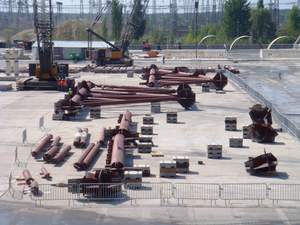SLAVUTICH, UKRAINE--(Marketwire - May 24, 2012) - When reactor No. 4 at the Chernobyl Nuclear Power Plant exploded in the early morning hours of April 26, 1986, a disaster of mammoth proportions unfolded. Radioactive material blew as high as six miles and covered more than 60,000 square miles. A quarter century later, the first structure built to enclose the reactor needs to be replaced.
That's where a consortium including Battelle comes in. With a reputation for excellence in confronting large, complex scientific and engineering challenges, Battelle scientists and engineers and colleagues from Bechtel International Systems Inc. and other companies have begun the most important part of the recovery process. Twenty-six years to the day -- April 26 -- after the disaster occurred, construction of a moveable building that weighs as much as three Eiffel Towers began. Battelle employees from corporate headquarters in Columbus, Ohio along with staff from Pacific Northwest National Laboratory in Richland, Wash., are working on the project.
It's part of the EUR 1.5 billion Shelter Implementation Plan (SIP), the master directive funded by donations from more than 30 nations to the Chernobyl Shelter Fund, which is administered by the European Bank for Reconstruction and Development. The Bank held an open international tender in 1997 for a project management unit to provide technical and fiduciary oversight for SIP works. It was won by a consortium of Battelle, Bechtel and Electricité de France (EDF withdrew from the consortium in 2010).
The SIP's confinement building is an enormous steel shelter called the New Safe Confinement (NSC), and it will help mitigate the radioactivity for the next century while disassembly and cleanup activities are conducted inside. Although the SIP consists of 22 tasks, the largest is construction of the NSC, an arch-shaped steel structure that is being built distant from the current Object Shelter to avoid radiation exposure of construction workers. Once construction of the arch is complete, the team will slide the NSC -- 250 meters wide, 150 meters long, 100 meters tall, built from one-meter diameter tubular steel and big enough to enclose the Statue of Liberty -- over the older Object Shelter. The project should be complete in 2015.
Many of the other 21 SIP tasks are complete, or nearly complete, including providing site infrastructure and conceptual design of the NSC (which was performed by Bechtel-Battelle-EDF 2002-2003 and approved by the Cabinet of Ministers of Ukraine in 2004). A contract for final design and construction of NSC was awarded in 2007 to the joint venture company known as Novarka. Novarka consists of the two large construction companies, Vinci Construction Grands Projets and Bouygues Travaux Publics (both French). The arch's steel is being fabricated in Italy.
Battelle's history of working on huge projects extends back to its beginning in 1929. Battelle scientists performed work for the United States government in developing nuclear energy 70 years ago. Today Battelle has a significant management role in six of the U.S. Department of Energy's premier national laboratories -- including important nuclear work performed at Oak Ridge National Laboratory and Idaho National Laboratory.
The SIP was developed in 1996 as a means to transform the Chernobyl Object Shelter to an environmentally safe condition. Development of SIP was led by Carol Kessler, then at the U.S. Department of State and later a Battelle employee in the Center for Nonproliferation.
About Battelle
As the world's largest independent research and development organization, Battelle provides innovative solutions to the world's most pressing needs through its four global businesses: Laboratory Management; National Security; Health and Life Sciences; and Energy, Environment and Material Sciences. It advances scientific discovery and application by conducting $6.5 billion in global R&D annually through contract research, laboratory management and technology commercialization. Headquartered in Columbus, Ohio, Battelle oversees 22,000 employees in more than 130 locations worldwide, including eight national laboratories for which Battelle has a significant management role on behalf of the U.S. Department of Energy, the U.S. Department of Homeland Security, and the United Kingdom.
Battelle also is one of the nation's leading charitable trusts focusing on societal and economic impact and actively supporting and promoting science, technology, engineering and mathematics (STEM) education.
Contact Information:
For more information contact
Katy Delaney
(614) 424-7208
T.R. Massey
(614) 424-5544
